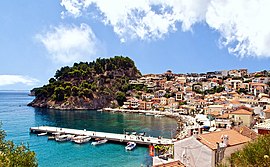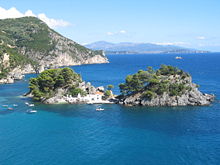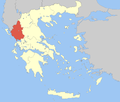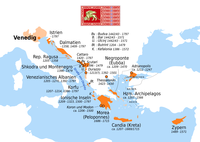This is an old revision of this page, as edited by Ahmet Q. (talk | contribs) at 01:51, 4 November 2020 (see TP). The present address (URL) is a permanent link to this revision, which may differ significantly from the current revision.
Revision as of 01:51, 4 November 2020 by Ahmet Q. (talk | contribs) (see TP)(diff) ← Previous revision | Latest revision (diff) | Newer revision → (diff) Settlement in Greece| Parga Πάργα | |
|---|---|
| Settlement | |
 View of Parga View of Parga | |
  | |
| Coordinates: 39°17′N 20°24′E / 39.283°N 20.400°E / 39.283; 20.400 | |
| Country | Greece |
| Administrative region | Epirus |
| Regional unit | Preveza |
| Government | |
| • Mayor | Nastas Antonios (since January 1, 2015) |
| Area | |
| • Municipal unit | 68.9 km (26.6 sq mi) |
| Elevation | 32 m (105 ft) |
| Highest elevation | 910 m (2,990 ft) |
| Lowest elevation | 0 m (0 ft) |
| Population | |
| • Municipal unit | 3,904 |
| • Municipal unit density | 57/km (150/sq mi) |
| • Community | 2,415 |
| Time zone | UTC+2 (EET) |
| • Summer (DST) | UTC+3 (EEST) |
| Postal code | 480 60 |
| Area code(s) | 26840 |
| Vehicle registration | ΡΖx |
| Website | parga.gr |
Parga (Template:Lang-el [ˈpaɾɣa]) is a town and municipality located in the northwestern part of the regional unit of Preveza in Epirus, northwestern Greece. The seat of the municipality is the village Kanallaki. Parga lies on the Ionian coast between the cities of Preveza and Igoumenitsa. It is a resort town known for its natural environment.
Municipality
The present municipality of Parga was formed at the 2011 local government reform by the merger of the following 2 former municipalities, that became municipal units:
- Fanari
- Parga
The municipality has an area of 274.796 km, the municipal unit 68.903 km.
History

In antiquity the area was inhabited by the Greek tribe of the Thesprotians. The ancient town of Toryne was probably located here. Mycenean tholos tombs have been discovered in the vicinity of Parga.
Parga itself is mentioned for the first time in 1318; the name is most likely of Slavic origin. Two years later, the town and its sugarcane plantation proceeds were unsuccessfully offered by Nicholas Orsini, the Despot of Epirus, to the Republic of Venice in exchange for Venetian aid against the Byzantine Empire. During the Epirote rebellion of 1338/39 against the Byzantine emperor Andronikos III Palaiologos, Parga remained loyal to the emperor. The town came under the control of John Spata of Arta in the 1390s. Vonko, who was also vassal of the Venetians in Fanari, was the governor Parga at this time. After Spata's death, he tried to carve his own fiefdom in 1400. The townspeople considered his rule tyrranical, overthrew him and asked the Venetians for protection.
The town passed under Venetian control in 1401, and was administered as a mainland exclave of the Venetian possession of Corfu, under a castellan. In the late medieval period, Parga was considered a part of Albania (latere Albaniae) in reference to the significant Albanian presence in the region. Venetian possession was later reconfirmed in the Ottoman–Venetian treaty of 1419. Ottoman raids were particularly heavy in the mid 15th century, as the senate gave the citizens of the town a 10-year tax exemption in 1454. A Romaniote Jewish community has been recorded in 1496 in Venetian Parga.
At 1570 Parga was under the control of Greek rebels under Emmanuel Mormoris that temporarily managed to overthrow Ottoman rule from the coastal regions of Epirus. Though under Venetian control the town was subject to raids by Ottoman Albanian bands. During Ottoman rule in Epirus, the inhabitants of Parga displayed continuous support for Greek revolutionary activities.
Apart from brief periods of Ottoman possession, the town remained in Venetian hands until the Fall of the Republic of Venice in 1797. It then passed to France. As the relations of France with Ali Pasha deteriorated over his ambitions against the mainland exclave of Parga, the French twice considered using the men of their Albanian Regiment against the mainland, but nothing came of these plans. The leading figure of political life of Parga in this transitional period was Hasan Çapari, strong adversary of Ali Pasha and very wealthy landowner from nearby Margariti, who in 1807 sought Russian support as the British navy was harassing the locals of Parga. In 1812 the adjacent settlement of Agia that belonged to Parga was captured by Daut Bey, nephew of Ali Pasha. He then massacred and enslaved the local population. Daut was killed during the following siege against Parga. In 1815, with the fortunes of the French failing, the citizens of Parga revolted against French rule and sought the protection of the British. In 1819, the British sold the city to Ali Pasha of Ioannina (the subject of Francesco Hayez's later painting The Refugees of Parga), and it later passed to full Ottoman rule. This decision was highly unpopular among the population of Parga, a predominantly Greek inhabited settlement as well as extremely pro-Venetian. Parga then ceased to provide a refuge for Klephts and Souliotes and many residents of Parga moved to nearby Corfu rather than live under Ottoman rule.
During the first year of the Greek War of Independence (1821) the Ottoman garrison of Parga was unsuccessfully attacked by a small force of Souliotes and men of the local diaspora. Based on a 1877 report by the local Greek vice consul, in Parga lived 365 Christian and 180 Muslim families. Both communities were mainly Greek speaking, while some Muslims also spoke Albanian. In the early 20th century, apart from Albanian speakers, a considerable part of the Parga Muslims were Greek speakers and Romani, many of which had emigrate in the area from southern Greece after the Greek war of independence in 1821.Ottoman rule in Parga and the rest of Epirus ended in 1913 following the victory of Greece in the Balkan Wars, and the town became part of Greece. As a result of the Population exchange between Greece and Turkey, the state of Greece in November 1924 transported to Turkey, 1,500 Albanian-speaking Muslims from Parga, as not being of Albanian origin. The Muslims of Parga had acquired Ottoman citizenship in 1913, but had later renounced it. On this basis, the Greek government considered them to be Turkish. As a result of protests, a Mixed Commission under the League of Nations with representatives from Greece and Albania was formed. On February 2, 1926 Qenan Mesare, the Albanian representative protested against the forced relocations to Turkey from the region of Chameria , the worsening of the living conditions for the Cham community and specifically referred to the villge of Parga, where the majority were transferred to Turkey. In 1927, a group of 20 Muslim families petitioned for their planned exchange to be annulled. This small group was eventually allowed to remain in Parga via mediation by the League of Nations which made their status "non-exchangeable".
During the Axis Occupation of Greece, in August 1943, Parga was targeted by the German anti-guerilla operation named 'Augustus'. The Wehrmacht units were actively assisted by units of the Italian army and armed Cham Albanian groups under Nuri Dino, Mazar Dino and Abdul Qasim. On 28 June, 1944 the National Republican Greek League took the village and killed 52 Albanians. The following month the left wing National Liberation Front arrested 40 local Muslims and executed them. The remaining members of the Muslim community were saved by units of the right wing National Republican Greek League of Napoleon Zervas. In general violent incidents in Summer-Autumn 1944 were quite limited and the civilian Muslim community was not found in danger. At the end of the war, the remaining Muslim Chams fled to Albania.
Various cultural and educational foundations in Parga were erected due to bequests by prominent locals, such as Athanasios Deskas.
Castle of Parga
Main article: Parga Castle
The Castle is found on the top of a hill overlooking the town and was used to protect the town from invasions from the mainland and the sea. It was initially built in the 11th century by the residents of Parga to protect their town from pirates and the Ottomans. In the 13th century, as their control of the region increased, the Venetians rebuilt the castle to fortify the area. In 1452, Parga and the castle were occupied by the Ottomans for two years; part of the castle was demolished at that time. In 1537, Ottoman admiral Hayreddin Barbarossa burned and destroyed the fortress and the houses within.
Before the reconstruction of the castle in 1572 by the Venetians, the Turks demolished it once again. The Venetians rebuilt it for the third and last time creating a stronger fortress that stayed impregnable until 1819, despite attacks, especially by Ali Pasha of Ioannina. Provisions for the castle were transported via two bays at Valtos and Pogonia. When Parga was sold to the Ottomans, Ali Pasha made structural additions to the castle, including a Turkish bath and his harem quarters which he built at the top of the fortress. On the arched gate at the wall of the castle entrance, the winged lion of Agios Markos is visible. Other entrance details include, the name “ANTONIO BERVASS 1764”, emblems of Ali Pasha, two-headed eagles and related inscriptions.
Geography


The city of Parga, built amphitheatrically, stands between the mountainous coastal region of Preveza and Igoumenitsa. It is known as the "Bride of Epirus". In the summer, tourists arrive from Paxos, Antipaxos, and Corfu by boat.
Beaches
Parga attracts thousands of tourists. In its vicinity there are beaches including Valtos, Kryoneri, Piso Kryoneri, Lichnos, Sarakiniko and Ai Giannaki.
Valtos Beach

Valtos Beach is one of the best and longest beaches of Parga. It is located near the castle of Parga. Because of its clear waters and proximity to Parga it attracts many tourists.
Krioneri Beach
Krioneri Beach, the main beach of Parga, lies a short distance from the town centre. The small island of Virgin Mary is situated across the bay.
Lichnos Beach

Lichnos Beach, one of the beaches of Parga, is located in western Greece 3 km from Parga and Spread in the area of 2 hectares.
Agios Sostis beach
Agios Sostis is a small beach on the northwest side of Anthoussa village. A small church, built in the 14th century, stands nearby.
Sarakiniko beach
Sarakiniko is a well-known beach, located on the west side of Agia village, near a small river and olive trees, approximately 12 km from the town centre. Small boats connect the beach with the port of Parga.
Transport

The town of Parga is linked with direct suburban buses (KTEL) to other Greek cities and towns such as Igoumenitsa and Preveza. There are also indirect connections with Athens. Thessaloniki and Ioannina
Tourists arriving in Parga fly in from Aktio (65 km) with seasonal direct flights connecting Parga with Athens, Thessaloniki and other domestic and international destinations. Tourists also arrive via the Ioannina and Corfu airports.
Parga is located 10 km from national road ![]() and 34 km from national motorway
and 34 km from national motorway ![]() .
.
Municipal districts
- Agia (Agia, Sarakiniko)
- Anthousa (Anthousa, Trikorfo)
- Livadari (Livadari, Vryses)
- Parga (Parga, Agia Kyriaki, Agios Georgios, Maras, Chrysogiali)
Historical population
| Year | Town | Municipal unit | Municipality |
|---|---|---|---|
| 1981 | 1,892 | - | - |
| 1991 | 1,699 | 3,569 | - |
| 2001 | 2,432 | 4,033 | - |
| 2011 | 2,415 | 3,904 | 11,866 |
Notable people
- Pargalı Ibrahim Pasha (1493–1536), a grand vizier in the Ottoman Empire
- Andreas Idromenos (1764–1843), scholar
- Panagiotis Aravantinos (1811–1870), historian and scholar
- Ioannis Dimoulitsas, fighter of the Greek War of Independence
- TUS (1986), Greek rapper
- ALKIS ALKAIOS (1949-2012),Greek poet
See also
References
- "Απογραφή Πληθυσμού - Κατοικιών 2011. ΜΟΝΙΜΟΣ Πληθυσμός" (in Greek). Hellenic Statistical Authority.
- ^ "Kallikratis law" (PDF) (in Greek). Greece Ministry of Interior. Retrieved 2015-07-31.
- "Population & housing census 2001 (incl. area and average elevation)" (PDF) (in Greek). National Statistical Service of Greece.
-
 Smith, William, ed. (1854–1857). "Toryne". Dictionary of Greek and Roman Geography. London: John Murray.
Smith, William, ed. (1854–1857). "Toryne". Dictionary of Greek and Roman Geography. London: John Murray.
- Papadopoulos, Thanasis (1995). "A LATE MYCENAEAN KOINE IN WESTERN GREECE AND THE ADJACENT IONIAN ISLANDS". Bulletin of the Institute of Classical Studies. 40 (Supplement_63): 201–208. doi:10.1111/j.2041-5370.1995.tb02112.x. ISSN 0076-0730.
- ^ Soustal, Peter; Koder, Johannes (1981). Tabula Imperii Byzantini, Band 3: Nikopolis und Kephallēnia (in German). Vienna: Verlag der Österreichischen Akademie der Wissenschaften. pp. 226–227. ISBN 3-7001-0399-9.
- Osswald 2011, p. 230.
- Asonitis, Spyros (1999). : 30 https://ejournals.epublishing.ekt.gr/index.php/ieim/article/view/24736/0.
Μια σύντομη αναφορά εγγράφου του Ιστορικού Αρχείου της Κέρκυρας, που μας πληροφορεί ότι το 1400 οι Κερκυραίοι... εξασφάλιζε στο κάστρο αυτό η Βενετία
{{cite journal}}: Cite journal requires|journal=(help); Missing or empty|title=(help); soft hyphen character in|quote=at position 67 (help) - Ossward 2011, p. 330:Inversement, le terme Albania fut parfois employé à la fin du Moyen Âge pour désigner l’Épire, à l’époque où les Albanais y tinrent une place importante. C’est le cas en 1395, lorsque Nicolai Marthono situe Parga a latere Albaniae (Inversely, the term Albania was used in the Middle Ages as a designation for Epirus, in a period during which the Albanians held a strong position in the region) sfn error: no target: CITEREFOssward2011 (help)
- Osswald 2011, p. 303:En 1454, Parga subit des dégâts si importants que la République accorda aux habitants de la ville une exemption d’impôts d’une durée de dix ans
- Osswald 2007, p. 130.
- Vranousis, L.; Sfyroeras, V. (1997). "From the Turkish Conquest to the Beginning of the Nineteenth Century: Revolutionary Movements and Uprisings". Epirus, 4000 Years of Greek History and Civilization: 244–251. ISBN 9789602133712.
- Amoretti, Guido (2007). " The Serenissima Republic in Greece: XVII- XVIII Centuries : from the Drawings of Captain Antonio Paravia and the Archives of Venice. Omega. p. 160.
This was a typical border town , which like so many of its neighbours , was in a constant state of conflict with the Albanians .
- Fleming, K. E. The Muslim Bonaparte: Diplomacy and Orientalism in Ali Pasha's Greece. Princeton University Press. p. 70-71. ISBN 978-1-4008-6497-3.
Parga, Vonitza, Preveza, and Butrinto. In 1401 the peoples of Parga had established the precedent of colluding with Venice by placing themselves voluntarily under Venetian protection, thus staying the advance of the Ottomans... These territories came to be known for their staunch support of the Greek revolutionary causeand Parga colluded with the independent Orthodox, and Parga colluded with the independent Orthodox peoples of Souli in their chronic battles with Ali Pasha.
- Pappas, Nicholas Charles (1982). Greeks in Russian Military Service in the Late Eighteenth and Early Nineteenth Centuries. Stanford University. pp. 265, 388.
Kolokotrones claims that Ali Farmaki and he recruited 3000 Chams, who gathered at Parga to embark first to Lefkas and Zante and then hence to the Peloponnesus, only to have the whole plan aborted by the English capture of Zante (...)
- Balta, Oğuz & Yaşar 2011, p. 364.
- Frary, Lucien (2019). "The Russian consulate in the Morea and the outbreak of the Greek Revolution, 1816-21". In Suonpää, Mika; Wright, Owain (eds.). Diplomacy and Intelligence in the Nineteenth-Century Mediterranean World. Bloomsbury Publishing. pp. 59–63. ISBN 1474277055.
Vlassopoulos's diplomacy focused on defending the neighbouring population of Parga, whose leader, Hasan Agha Tsapari, had sought Russian support. (..) Weeks later, Vlassopoulos reported that British naval vells were harassing the residents of Parga, who were seeking protection from the tsar.
- Russell, Eugenia; Russell, Quentin. Ali Pasha, Lion of Ioannina: The Remarkable Life of the Balkan Napoleon. Pen and Sword. p. 86. ISBN 978-1-4738-7722-1.
- Amoretti, Guido (2007). The Serenissima Republic in Greece: XVII- XVIII Centuries : from the Drawings of Captain Antonio Paravia and the Archives of Venice. Omega. p. 160.
The inhabitants, who were mostly Greeks and extremely loyal to the Venetian flag , refused to become Moslem subjects and decided to abandon their home .
- Dakin, Douglas. The Greek Struggle for Independence, 1821-1833. University of California Press. p. 45. ISBN 978-0-520-02342-0.
- Jim Potts (2010). The Ionian Islands and Epirus: A Cultural History. Oxford University Press. p. 154. ISBN 978-0-19-975416-8.
- Nikolaidou, Eleftheria (1997). "Epirus and the Greek War of Independence". Epirus, 4000 Years of Greek History and Civilization: 275. ISBN 9789602133712.
- Skoulidas, Ilias (2001). "The Relations Between the Greeks and the Albanians During the 19th Century: Political Aspirations and Visions (1875–1897)". didaktorika.gr. University of Ioannina: 81. doi:10.12681/eadd/12856.
Έτσι ο διευθύνων το υποπροξενείο της Πάργας σημείωνε ότι...
- Tsoutsoumpis, Spyros (December 2015). "Violence, resistance and collaboration in a Greek borderland: the case of the Muslim Chams of Epirus". Qualestoria (2): 121. Retrieved 14 June 2016.
While the majority of local Muslims were Albanian-speakers, there was a significant presence of Roma and Greek-speaking Muslims in the towns of Parga and Paramithia, many of whom had emigrated from southern Greece after the 1821 revolution
- Archived December 5, 2011, at the Wayback Machine
- Tsitselikis, Konstantinos (2012). Old and New Islam in Greece: From Historical Minorities to Immigrant Newcomers. Martinus Nijhoff Publishers. p. 442. ISBN 9004221522.
- Sadik, Blerina (2018). "Population Exchange between Greece and Turkey". In Motta, Giuseppe (ed.). Dynamics and Policies of Prejudice from the Eighteenth to the Twenty-first Century. Cambridge Scholars Publishing. ISBN 1527517004.
He referred to the case of Parga, where the majority of the population was forced to relocate to Turkey
- Tsitselikis, Konstantinos (2012). Old and New Islam in Greece: From Historical Minorities to Immigrant Newcomers. Martinus Nijhoff Publishers. p. 442. ISBN 9004221522.
- Γκότοβος, Αθανάσιος (2013). Ετερότητα και σύγκρουση: ταυτότητες στην κατοχική Θεσπρωτία και ο ρόλος της Μουσουλμανικής μειονότητας. University of Ioannina, Dodoni Journal. p. 45.
Αφορά εκκαθαριστικές επιχειρήσεις στην περιοχή νοτίως της Παραμυθιάς, μέχρι την Αμμουδιά και την Πάργα...
- Petrov, Bisser (2009). "National Republican Greek League EDES". Etudes balkaniques. 45 (3–4). Academy of Sciences of Bulgaria: 30.
On June 27, 1944, EDES units overran the town of Paramythia and killed about 600 Albanians. On the next day, another EDES battalion reached Parga and killed another 52.
- Tsoutsoumpis, Spyros (December 2015). "Violence, resistance and collaboration in a Greek borderland: the case of the Muslim Chams of Epirus". Qualestoria (2): 137. Retrieved 14 June 2016.
- Γκότοβος, Αθανάσιος (2013). Ετερότητα και σύγκρουση: ταυτότητες στην κατοχική Θεσπρωτία και ο ρόλος της Μουσουλμανικής μειονότητας. University of Ioannina, Dodoni Journal. pp. 45, 65.
...την Πάργα και τους Φιλιάτες το καλοκαίρι και το Φθινόπωρο του 1944 ήταν εξαιρετικά περιορισμένα, και αυτό επειδή τελικά ο Ζέρβας μπόρεσε να επιβάλει την αναγκαία πειθαρχία για την περιφρούρηση του συγκεντρωμένου σε διάφορα ασφαλή σημεία άμαχου μουσουλμανικού πληθυσμού
- Mazower, Mark (2000). "Three Forms of Political Justice, 1944-1945". After The War Was Over: Reconstructing the Family, Nation and State in Greece, 1943–1960 (illustrated ed.). Princeton, New Jersey: Princeton University Press. pp. 25–26. ISBN 9780691058429. Retrieved 15 March 2009.
- Ploumidis, G. (1997). "Cultural Life in Epirus". Epirus. Ekdotike Athenon: 418.
The overwhelming majority of the bequests were to Ioannina, followed by ... Parga... Many school buildings are due to bequests:... Thanasis Deskas at Parga
- Archived August 28, 2011, at the Wayback Machine
- Archived August 27, 2011, at the Wayback Machine
- https://web.archive.org/web/20110827162735/http://www.parga.gr/site/?page_id=44&lang=en. Archived from the original on August 27, 2011. Retrieved November 13, 2011.
{{cite web}}: Missing or empty|title=(help) - https://web.archive.org/web/20110826024406/http://www.parga.gr/site/?page_id=46&lang=en. Archived from the original on August 26, 2011. Retrieved November 13, 2011.
{{cite web}}: Missing or empty|title=(help) - https://web.archive.org/web/20110828110343/http://www.parga.gr/site/?page_id=50&lang=en. Archived from the original on August 28, 2011. Retrieved November 13, 2011.
{{cite web}}: Missing or empty|title=(help) - "Beaches For Camping In Europe". Retrieved March 29, 2018.
- https://web.archive.org/web/20110825233321/http://www.parga.gr/site/?page_id=48&lang=en. Archived from the original on August 25, 2011. Retrieved November 30, 2011.
{{cite web}}: Missing or empty|title=(help) - "Αρχική Σελίδα". Ktel-thesprotias.gr. Retrieved 2015-07-30.
- ^ "ΚΤΕΛ ΝΟΜΟΥ ΠΡΕΒΕΖΑΣ Α.Ε. :: Καλώς ήλθατε". Ktelprevezas.gr. Retrieved 2015-07-30.
- "йтек иыаммимым а.е". Ktelioannina.gr. Retrieved 2015-07-30.
Sources
- Balta, Evangelia; Oğuz, Mustafa; Yaşar, Filiz (2011). "Εthnic and Religious Composition of Ottoman Thesprotia in the 15th to 17th centuries". In Forsén, Björn; Tikkala, Esko (eds.). Thesprotia Expedition II. Environment and Settlement Patterns. Foundation of the Finnish Institute at Athens. ISBN 978-952-67211-2-5.
- Osswald, Brendan (2007). "The Ethnic Composition of Medieval Epirus". In Ellis, Steven G.; Klusáková, Lud'a (eds.). Imagining Frontiers, Contesting Identities. Pisa: Edizioni Plus – Pisa University Press. ISBN 978-88-8492-466-7.
{{cite book}}: External link in|chapterurl=|chapterurl=ignored (|chapter-url=suggested) (help) - Osswald, Brendan (2011). L'Epire du treizième au quinzième siècle : autonomie et hétérogénéité d'une région balkanique (Thesis). Université Toulouse le Mirail - Toulouse II.
| Administrative division of the Epirus Region | ||
|---|---|---|
| Regional unit of Arta |  | |
| Regional unit of Ioannina | ||
| Regional unit of Preveza | ||
| Regional unit of Thesprotia | ||
| ||
| Subdivisions of the municipality of Parga | |
|---|---|
| Municipal unit of Fanari | |
| Municipal unit of Parga | |
| Stato da Màr of the Republic of Venice | ||
|---|---|---|
| Adriatic Sea |
|  |
| Ionian Islands and dependencies |
| |
| Mainland Greece |
| |
| Aegean Islands |
| |
| Other |
| |
| Related articles | ||